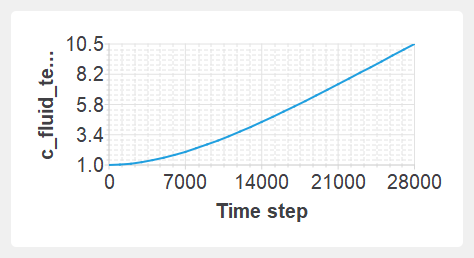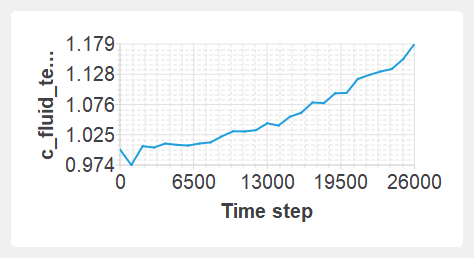I am trying to simulate dilute polymer solution with uniform velocity U approaching a stationary sphere. For this purpose, I am initially using dpd particles placed in parallel plates and then moving the parallel plates with certain velocity so that dpd particles achieve velocity of plate. After that I will put beads with spring in that system then sphere made of dpd particles.
But, I am stuck in the initial phase for creating uniform flow using parallel plate. Though the flow generated by moving plates is uniform but it does not matches the plate velocity, the uniform velocity is more than plate velocity. I am attaching the input script used in my simulation
##start of script
Initialization
units lj
dimension 3
boundary p p s
atom_style dpd
Ensure ghost atoms store velocities for DPD pair style
comm_modify vel yes
Create simulation box
region simbox block -30 30 -4 4 -12 12
create_box 2 simbox
Set masses for atom types
mass 1 1.0 # Mass for plate particles (Group A)
mass 2 1.0 # Mass for fluid particles (Group B)
Define regions for plates and fluid
region lower_plate block -30 30 -4 4 -12 -10
region upper_plate block -30 30 -4 4 10 12
region FLUID block -30 30 -4 4 -10 10
region FLUID2 block -30 30 -4 4 -9.9999999 9.9999999
Create atoms for plates with high density
lattice fcc 6
create_atoms 1 region lower_plate
create_atoms 1 region upper_plate
Create atoms for fluid with lower density
lattice fcc 4
create_atoms 2 region FLUID
Group definitions
group lowerplate region lower_plate
group upperplate region upper_plate
group fluid region FLUID
group walls union lowerplate upperplate
group fluid_v region FLUID2
Define DPD settings
pair_style dpd 1.0 2.0 12345 #
pair_coeff 1 1 0.0 4.5 2.0 # No interaction between wall particles
pair_coeff 1 2 18.75 4.5 2.0 # Interaction between wall and fluid particles, initially 9.68
pair_coeff 2 2 18.75 4.5 2.0 # Interaction between fluid particles
Freeze wall particles
fix freeze_walls walls setforce 0.0 0.0 0.0
Reflective boundary conditions for fluid particles at plate boundaries
fix wall_lower fluid wall/reflect zlo EDGE
fix wall_upper fluid wall/reflect zhi EDGE
Move the plates with a certain velocity along the x-axis
variable plate_velocity equal 0.35 # Set the plate velocity
velocity lowerplate set v_plate_velocity 0.0 0.0
velocity upperplate set v_plate_velocity 0.0 0.0
Neighbor list settings
neighbor 2 bin # Increase the skin distance
neigh_modify delay 0 every 1 check yes
Time integration using NVT for thermostatting
fix 2 fluid nvt temp 1.0 1.0 0.5 # Nose-Hoover thermostat applied to fluid
Initial velocities for fluid particles
velocity fluid_v create 1.0 12345
Chunks along z-axis (cuboidal binning)
compute cuboidChunks fluid chunk/atom bin/3d x lower 1 y lower 1 z lower 1 units box
Compute temperature for fluid region
compute fluid_temp fluid temp/region FLUID
Fixes for averaging density and velocity in cuboidal bins
fix aveCuboid fluid ave/chunk 100 10 1000 cuboidChunks density/number vx vy vz norm sample file cuboid_density_velocity.txt
Output settings
thermo 100
thermo_style custom step temp c_fluid_temp
Dump temperature of the fluid region only
dump 1 fluid custom 100 fluid_temp.lammpstrj id type x y z vx vy vz fx fy fz
dump 2 all custom 100 dumpvel.lammpstrj id type x y z vx vy vz fx fy fz
restart setting
restart 5000 restart.lammpstrj
Run settings
timestep 0.0025 # Reduce the time step for stability
run 100000
##end of script
I have created two regions FLUID and FLUID2, FLUID2 region is subset of FLUID region with y range being slightly small. I have used this region to create initial random velocity in the FLUID. As If I create random velocity in FLUID region, dpd particles diffuses in wall. The wall particles are going with a velocity of about 3.8 (This is ave/chunk calculated value).
What is causing this issue, I have checked with low velocity also (plate velocity 0.05) it is also showing same phenomena. Is there any alternate way to get uniform controlled velocity?
P.S. I am new to lammps and DPD simulations in lammps
 This is for dt=0.01
This is for dt=0.01